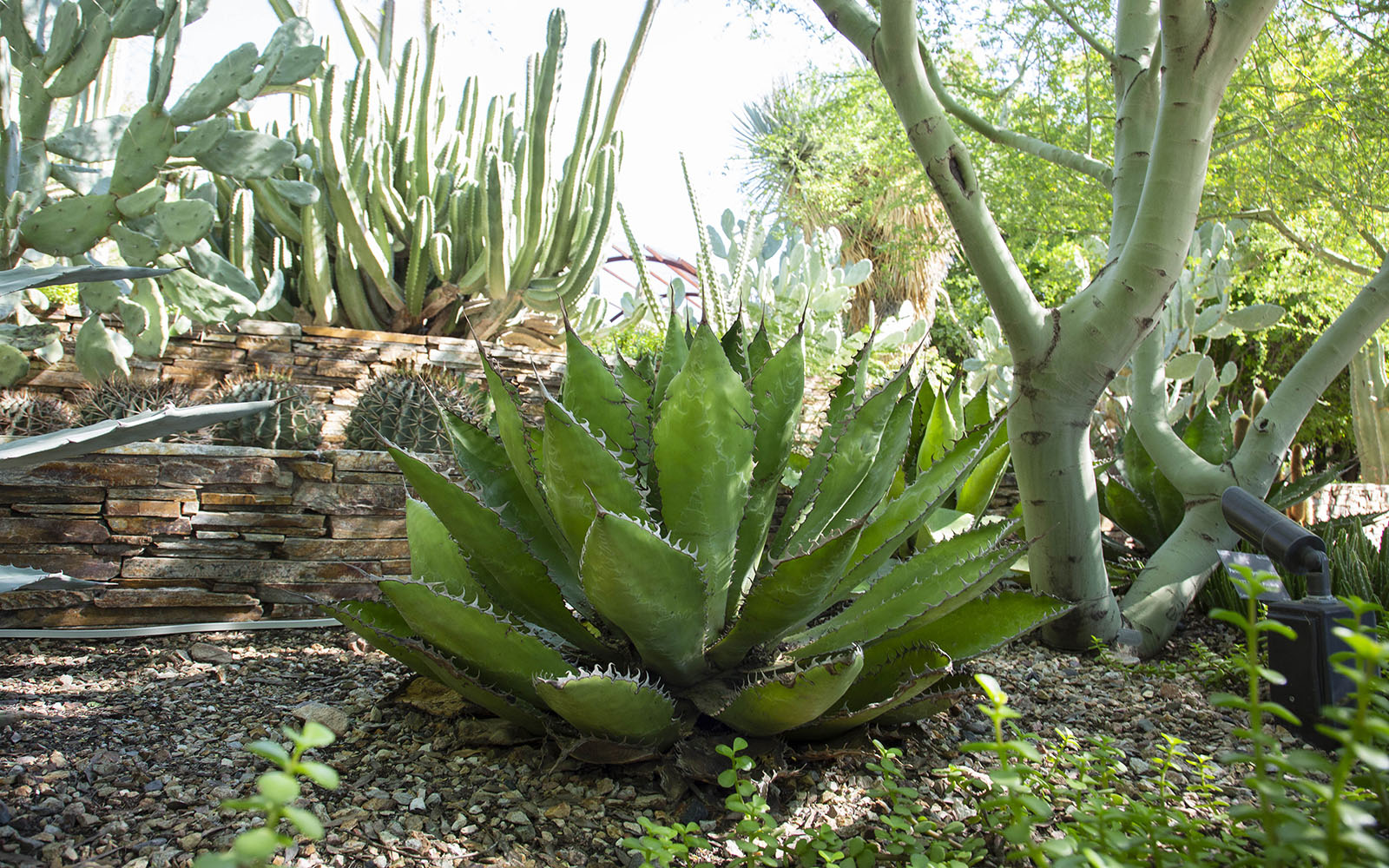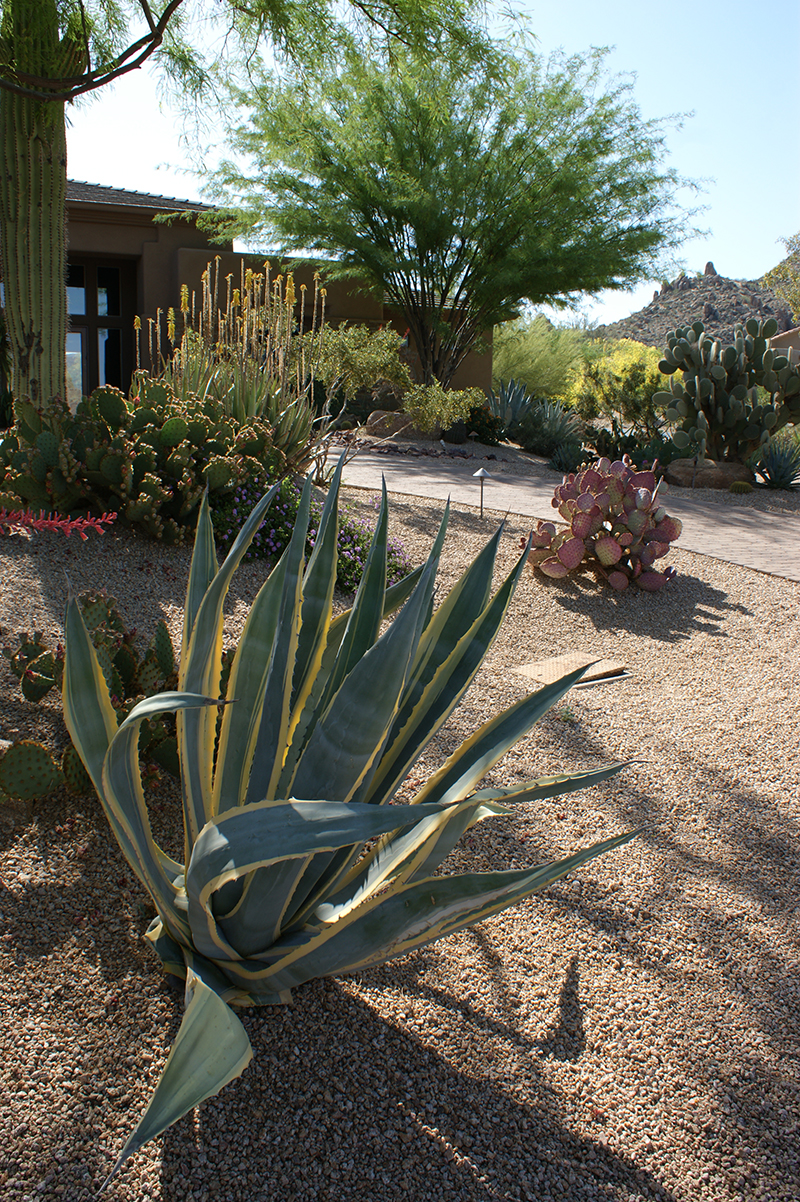
Xeriscaping: Landscaping with Style in the Arizona Desert
A step-by-step guide to xeriscaping and how to create a sustainable and beautiful desert-adapted landscape.
Seven Principles of Xeriscaping
1
Good Planning and Design
Creating a long-term plan will help you get the most out of your landscape while considering issues like cost, function, aesthetic preferences, maintenance requirements, water efficiency and energy efficiency. You can tailor the plan to suit your taste, your needs and your checkbook.
3
Appropriate Turf Areas
Although turf generally requires more water and maintenance than low water use plants, sometimes only grass will do, especially if there are children or pets at home. Small turf areas can be incorporated successfully into a xeriscape if they are properly planned, installed and maintained.

2
Low Water Use Plants
There are hundreds of water thrifty native or desert-adapted plants available at local nurseries. They come in all shapes and sizes and serve a variety of purposes from shade to seasonal color to screening unsightly areas. Many low water use plants have beautiful flowers or interesting forms.
4
Efficient Irrigation
In the desert, almost all new plants should be watered regularly to get them established, and most plants will need some kind of regular irrigation. Design your irrigation system so plants with similar watering needs are on the same valve. Water deeply and infrequently, and remember to adjust irrigation seasonally.
5
Soil Improvements
Desert-adapted plants will naturally thrive in our environment without fertilizers or soil supplements. Provide good drainage and loosen the soil when planting to encourage healthy root growth. Soil amendments will most likely be needed for turf areas and areas where more water thirsty plants are installed.
6
Use of Mulches
Mulches cover and cool the soil, reduce evaporation, and help to inhibit weed growth and erosion. The most popular organic mulches are bark chips and wood grindings. Fallen leaves and flowers can also be left as mulch. Decomposed granite and crushed rock are two of the most popular inorganic mulches.
7
Appropriate Maintenance
When properly designed and maintained, xeriscapes save water, time and money through reduced plant water needs and lower maintenance requirements. But that does not mean no water use and no attention. All landscapes need some care, and a well-maintained irrigation system will keep plants healthy and water use to a minimum.
Acknowledgements
About
This website is an interactive, online adaptation of the book Xeriscape: Landscaping with Style in the Arizona Desert, published in 2000. The original publication was developed by AMWUA with funding from the State of Arizona Department of Water Resources (ADWR) Water Management Assistance Program.
The first web-based adaptation of Landscaping with Style was launched in 2010 as a collaborative effort of AMWUA and ADWR. AMWUA is pleased to continue the partnership with this latest update to the project, launched in 2019.
Original Contributors
Special thanks to: The Xeriscape Guide Advisory Committee for supporting this project and for providing information, text reviews and project guidance: Robyn Baker, City of Scottsdale; Lucy Bradley, Maricopa County Cooperative Extension; Donna DiFrancesco, City of Mesa; Cheryl Goar, Arizona Nursery Association; Lisa Helm, Arizona Municipal Water Users Association; Thom Hulen, Desert Botanical Garden; Mary Irish, Garden Writer; Heidi Koopman, Arizona Landscape Contractors Association; Kent Newland and Andy Terrey, City of Phoenix; David Schultz, City of Glendale; Jim Wheat, FASLA; Elaine Averitt and Marjie Risk, Arizona Department of Water Resources.
A subset of the Advisory Committee also served as the Working Group for this project: Robyn Baker, Donna DiFrancesco, Lisa Helm, Kent Newland, David Schultz, Elaine Averitt and Marjie Risk. They contributed to every aspect of the project including project planning and refinement, providing reference materials, selecting photographs for the guide, and providing technical expertise. Their support, dedication to the project, and countless hours of service were invaluable.
Reviewers
Landscape Professionals: Grant Boden, Grant Boden Design; Libby Davison, University of Arizona; Ron Dinchak, Mesa Community College; Greg Flanagan, G.K. Flanagan Associates; Jeff Lee, City of Mesa; Joanne Littlefield and Terry Mikel, Maricopa County Cooperative Extension; Judy Mielke, Logan, Simpson Design; Jeff Nichols, Elgin Nursery; Steve Priebe, City of Phoenix; Janet Rademacher, Mountain States Nursery; Mike Rockwell, Azul-Verde Design Group, Inc.; Jeff Sargent, Tetra Tech; Selby Saubolle, Poco Verde Landscaping; Patsy Waterfall, Pima County Cooperative Extension-Low 4 Program. Homeowners: Debrah Dejardin, Betsy Dichter, Mary Engbrecht, Brenda Hammond, Virginia Hedlesky, Barbara Homan, Kathy Glass, John Kent, Andy Kurtz, Don Lewis, Tim Lukasik, Dave Parkin, Michelle Peters, Bernard Peterson, Lori Rogers, Bill Tatum, Greg Thorell, and Richard Williams. Development Community: Gary Carlson, M/I Homes.
Additional Thanks
Thanks also to: Donna DiFrancesco for providing information on plant stress, staking, and the watering schedule for new plants; David Schultz, Andy Terrey and Jeff Lee for providing information on drip irrigation systems; University of Arizona/Cooperative Extension staff Lucy Bradley, Patsy Waterfall, Della Fletcher, Libby Davison and the late Jimmy Tipton for providing information on plant pruning, fertilizing and staking; the University of Arizona Cooperative Extension and artist, Linda Lucz-Hatfield, for granting permission to use the planting, pruning, scoring and staking diagrams created originally for the brochure, Care of Desert Adapted Plants.
Disclaimer
This guide was produced with funding from the State of Arizona Department of Water Resources Water Management Assistance Program. This document is not intended to be used as legally binding design, construction or maintenance standards. The author of this document and the State of Arizona Department of Water Resources assume no responsibility for damages, financial or otherwise, which may result from the use of these guidelines.
The use of any specific type, model or brand of product or material in this guide should not be presumed to represent a promotion or endorsement of said product or material by the State of Arizona Department of Water Resources, its agents or representatives.